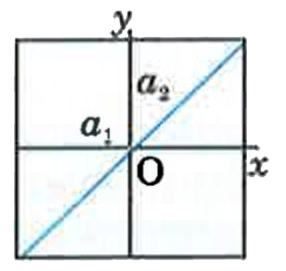A particel which is simultaneously subjected to two perpendicular simple harmonic motions represented by and traces a curve given by :




The correct Answer is:A
To solve the problem of finding the curve traced by a particle subjected to two perpendicular simple harmonic motions represented by x=a1cos(ωt) and y=a2cos(2ωt), we will follow these steps:
Step 1: Understand the given equations
We have two equations:
- x=a1cos(ωt)
- y=a2cos(2ωt)
Step 2: Express cos(2ωt) in terms of cos(ωt)
Using the double angle formula for cosine:
cos(2θ)=2cos2(θ)−1
we can write:
cos(2ωt)=2cos2(ωt)−1
Step 3: Substitute cos(ωt) in terms of x
From the first equation, we can express cos(ωt):
cos(ωt)=xa1
Now substituting this into the expression for cos(2ωt):
cos(2ωt)=2(xa1)2−1=2x2a21−1
Step 4: Substitute into the equation for y
Now we substitute this back into the equation for y:
y=a2(2(xa1)2−1)
This simplifies to:
y=a2(2x2a21−1)=2a2a21x2−a2
Step 5: Rearrange the equation
Rearranging gives us:
y+a2=2a2a21x2
This can be rewritten as:
2a2a21x2=y+a2
Step 6: Identify the type of curve
The equation 2a2a21x2=y+a2 is in the form of a parabola, specifically:
x2=a212a2(y+a2)
This shows that the curve is a parabola that opens upwards.
Conclusion
The curve traced by the particle is a parabola symmetric about the y-axis.
---
We have two equations:
- x=a1cos(ωt)
- y=a2cos(2ωt)
Using the double angle formula for cosine:
cos(2θ)=2cos2(θ)−1
we can write:
cos(2ωt)=2cos2(ωt)−1
From the first equation, we can express cos(ωt):
cos(ωt)=xa1
Now substituting this into the expression for cos(2ωt):
cos(2ωt)=2(xa1)2−1=2x2a21−1
Now we substitute this back into the equation for y:
y=a2(2(xa1)2−1)
This simplifies to:
y=a2(2x2a21−1)=2a2a21x2−a2
Rearranging gives us:
y+a2=2a2a21x2
This can be rewritten as:
2a2a21x2=y+a2
The equation 2a2a21x2=y+a2 is in the form of a parabola, specifically:
x2=a212a2(y+a2)
This shows that the curve is a parabola that opens upwards.
The curve traced by the particle is a parabola symmetric about the y-axis.
Topper's Solved these Questions
- OSCILLATIONS Book:MODERN PUBLICATIONChapter:OSCILLATIONS Exercise:Competition File (JEE (Advanced) For IIT Entrance)
Explore 7 Videos
- OSCILLATIONS Book:MODERN PUBLICATIONChapter:OSCILLATIONS Exercise:Competition File (Multiple choice question)
Explore 11 Videos
- OSCILLATIONS Book:MODERN PUBLICATIONChapter:OSCILLATIONS Exercise:Competition File (Multiple choice questions) AIPMT/NEET other State Boards for Medical Entrance
Explore 14 Videos
- MOTION IN A STRAIGHT LINE Book:MODERN PUBLICATIONChapter:MOTION IN A STRAIGHT LINE Exercise:CHAPTER PRACTICE TEST
Explore 16 Videos
- PHYSICAL WORLD Book:MODERN PUBLICATIONChapter:PHYSICAL WORLD Exercise:Revision exercises (Long answer questions)
Explore 6 Videos
Similar Questions
A particle which is simultaneously subjected to two perpendicular simple harmonic motions represented by , x=a1coscot and y=a2cos2cot traces a curve given by:
View SolutionA particle is acted simultaneously by mutally perpendicular simple harmonic motion x=acosωt and y=asinωt. The trajectory of motion of the particle will be
View Solution
Knowledge Check
The epoch of a simple harmonic motion represented by x=√3sinωt+cosωtmis
A30∘B40.3∘C60∘D25∘A particle is acted simultaneously by mutually perpendicular simple harmonic motions x=a cosωt and y=asinωt. The trajectory of motion of the particle will be
Aan ellipseBa parabolaCa circleDa straight line.What is the phase difference between two simple harmonic motions represented by x1=Asin(ωt+π6) and x2=Acosωt?
Aπ6Bπ3Cπ2D2π3
A particle is acted simultaneously by mutually perpendicular simple hormonic motions x=acosωtandy=asinωt. The trajectory of motion of the particle will be
View SolutionA particle isolated simultaneously by mutually perpendicular simple harmonic motion x = a cos ωt and y = a sin ωt. The trajectory of motion of the particle will be:
View SolutionWhat is the phase difference between two simple harmonic motions represented by x1=Asin(ωt+π6) and x2=Acos(ωt)?
View SolutionWhat is the phase difference between two simple harmonic motions represented by X1=Asin[ωt+π3]andX2=Acosωt?
View SolutionA particle is acted simultaneously by mutually perpendicular simple harmonic motion x=acosωt and y=asinωt. The frequency of motion of the particle will be
View Solution